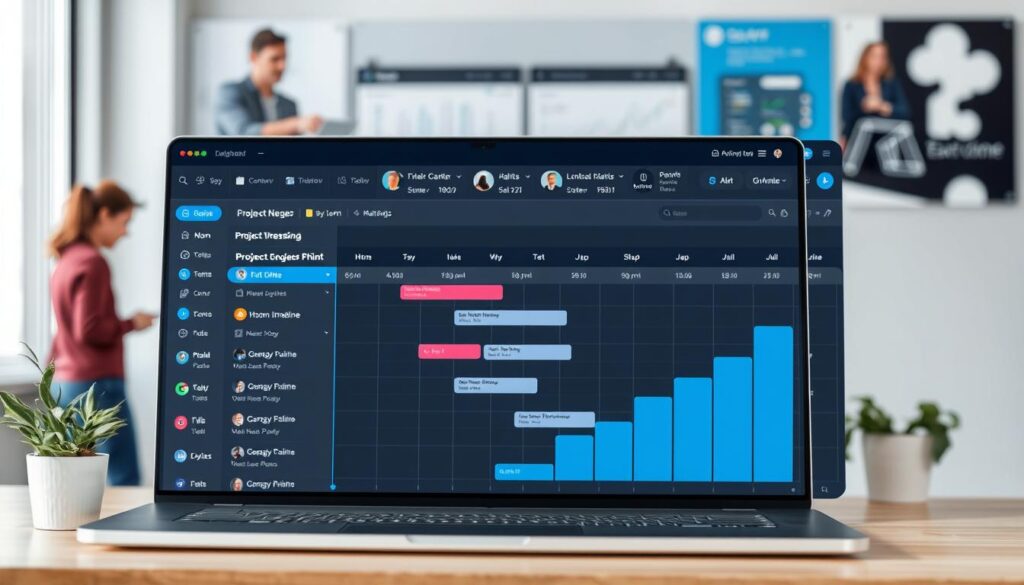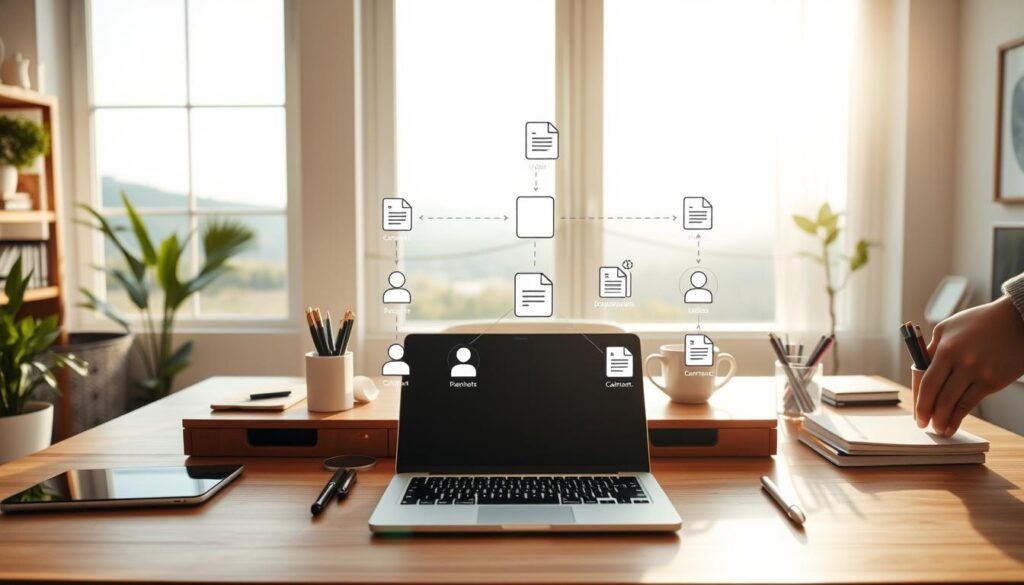The world of work is changing fast, and remote jobs are a big part of that change. Now, 84% of people working from home prefer it that way. This shows that working away from an office is becoming more common. It highlights the need to have the right tools for remote work. These tools help with teamwork, increase productivity, and meet business goals.
Starting out in remote work can be tricky with so many tools out there. We want to make it simpler for you. Our goal is to help you find not just any tools, but the best ones. These tools will make it easy to talk with your team, work together without problems, and stay connected, no matter where you or they are.
- Key Takeaways
- Introduction to Remote Work Tools for Beginners
- The Ultimate Guide to Setting Up Your Home Office
- Top Communication Tools for Virtual Collaboration
- Project Management Software to Keep You Organized
- Data Security and Privacy Tools for Remote Work
- Time Management Tools to Boost Productivity
- Document Collaboration and Sharing Platforms
- Remote Work Tools for Beginners
- Essential Hardware for the Remote Worker
- Maintaining Mental and Physical Health While Working Remotely
- Conclusion
- FAQ
- What are the essential tools needed for remote work beginners?
- How do I set up an ergonomic home office?
- What’s the difference between Slack, Microsoft Teams, and Zoom?
- Why is regular data backup important for remote workers?
- Can project management tools integrate with other apps?
- How do I protect sensitive information while working remotely?
- What are the benefits of using document collaboration tools like Google Drive or Dropbox?
- How can remote workers maintain a work-life balance?
- What steps should I take to stay healthy while working from home?
- How do time management tools like Toggl and Time Doctor improve productivity for remote workers?
Key Takeaways
- Identifying essential remote work tools to expedite and optimize telecommuting
- Utilizing must-have tools for remote work beginners to ensure smooth team integration
- Investing in remote work software for beginners to effectively manage tasks and projects
- Understanding the value of seamless communication in a distributed workforce environment
- Emphasizing the necessity of efficient and secure digital tools for enhancing home office setups
Introduction to Remote Work Tools for Beginners
Moving to work from home brings a need for easy-to-use, efficient tools. Our beginner’s guide to remote work tools looks at key platforms to help anyone start their remote work journey. These tools help with communication, working together, and staying organized, keeping the team productive and connected even when apart.

First, know the remote working tools for newbies. Whether it’s tools for managing projects or staying in touch, choosing the right ones is key. Below, we outline essential tools for remote workers to include in their day-to-day work for better results.
- Communication Platforms: Tools such as Slack and Microsoft Teams that enable instant messaging and video calls.
- Project Management Software: Applications like Asana and Trello that help manage tasks and deadlines effectively.
- Time Management Tools: Solutions like Toggl and Time Doctor that ensure efficient time tracking and productivity analysis.
With these basic tools, you’ll be ready to face remote work challenges and succeed online. This beginner’s guide to remote work tools aims to give newcomers a solid start in the digital work world.
The Ultimate Guide to Setting Up Your Home Office
Starting to set up a home office takes your work-from-home game up a notch. We’ll help you make a WFH area that boosts your work and well-being. It’s all about choosing the right ergonomic furniture and the newest tech.
Choosing the Right Space and Furniture
First, find a quiet spot away from busy home areas. It’s key to keeping your work and home life balanced. Choosing ergonomic furniture comes next. Buy a comfy ergonomic chair and a desk that changes height to keep your posture right and increase work output.
Essential Office Gadgets and Accessories
Your desk needs the best tools. Must-haves include double monitors and top-notch headphones for calls. Don’t forget office musts like smart chargers, an ergonomic keyboard, and a scanner. These keep your area tidy and running smoothly.
Reliable Internet Connection: A Necessity
A strong internet is key for remote work. Get a great router and maybe a WiFi booster or dongle for fast, stable internet. These tools are crucial for connecting to the worldwide office.

- Advanced surge protector — for protecting your equipment from power surges.
- External hard drives or cloud storage solutions — vital for data backup and organization.
Whether you’re setting up a simple or advanced remote office, these essentials are key for success. They blend tech and comfort for a top-notch work-from-home setup.
Top Communication Tools for Virtual Collaboration
Today, using top virtual collaboration tools is key for great communication and keeping up the company spirit. Slack, Microsoft Teams, and Zoom help make digital workplaces work well.
Comparing Slack, Microsoft Teams, and Zoom
Each platform meets different needs like video calls for remote work and instant chats. Let’s look at what each one brings to the table:
| Tool | Strengths | Best for |
|---|---|---|
| Slack | Instant communication, Integrations | Quick messaging and team-based projects |
| Microsoft Teams | All-in-one communication, Extensive meeting features | Integrated business applications and larger meetings |
| Zoom | High-quality video calls, Virtual backgrounds | Video-first communications and large webinars |
Benefits of Instant Messaging and Video Conferencing
Using these tools is great not only for work but for keeping the company culture alive. They make talking across different places and times easy.
Video chats especially help teams feel like a community, even from afar. They’re good for quick, informal talks that used to happen by the watercooler. This keeps teams close and workers engaged.

The best tool depends on what your team needs most. It’s all about what works best for your team’s vibe and helps everyone stay in touch.
Project Management Software to Keep You Organized
In today’s fast-paced work scene, using remote project management tools is key to stay on track. Trello, Asana, and Monday.com are top choices for their features of project management software. They meet different needs with their special features.
Using organizing with Asana helps teams manage tasks with detail. It turns complex projects into easier tasks. This boosts productivity and focus.
Trello’s Kanban boards make tracking stages and tasks simple. This visual way lets teams see project updates quickly. It’s essential for task management.
Monday.com helps teams see projects and tasks in many ways. It’s great for remote groups to work together well. It makes sure everything is noted.

These platforms are great because they can work with other apps. Linking them with apps like Slack or Google Drive helps everyone stay connected. This makes sure important info is easy to find and share.
| Tool | Main Features | Best For |
|---|---|---|
| Trello | Kanban-style boards, intuitive task tracking | Visual task management and progression tracking |
| Asana | Detailed to-do lists, project timelines, integrations | Complex projects requiring precise task management |
| Monday.com | Custom workflows, rich visualizations, large-scale collaboration | Teams needing flexible project management with extensive integrations |
Adapting to remote work means these project management tools are crucial. They help manage tasks, whether alone or in a group. And they keep our work flowing smoothly and efficiently.
Data Security and Privacy Tools for Remote Work
Remote work is growing fast, making data protection very important. It’s vital to use data security tools and privacy steps to keep information safe. This matters for working from any place on the globe.

Implementing VPNs and Encrypted Storage Solutions
VPNs help secure remote work by protecting network access. They keep data safe from being intercepted. A Virtual Private Network offers a protected connection over the less secure internet.
Using encrypted storage also keeps sensitive data safe, either stored locally or on the cloud. Tools like AES encrypted hard drives or SSL encryption help. They protect the confidentiality and integrity of data.
Understanding the Importance of Regular Data Backups
Regular data backups are key to avoid losing data. They help get data back after problems like cyber-attacks or hardware issues. Using cloud-based backup solutions is smart. They offer access to data from anywhere and make recovery easier. This helps teams keep working smoothly, no matter where they are.
Time Management Tools to Boost Productivity
If you’re working from home, getting good at managing your time is crucial. It’s key to staying productive. With the right digital tools, you can really step up your work game.

Two awesome tools, productivity boost with Toggl and Time Doctor for remote work, really stand out. They’re not just for tracking time. They show you how you spend your workday and offer useful insights. This helps you see where you can get better.
Using the Pomodoro technique with these tools breaks your day into focused chunks. It encourages working smarter with our time. Let’s dive into how these tools make our days better:
| Feature | Toggl | Time Doctor | Pomodoro Timer |
|---|---|---|---|
| Time Tracking | Basic tracking with start/stop | Automatic time tracking with screenshots | Set intervals of 25 minutes work with breaks |
| Analytics | Reports on time spent per project/task | Detailed insights, including websites and apps used | N/A |
| User Interface | Simple, intuitive design | More detailed, suited for team use | Minimalist timer design |
| Integration | Integrates with various productivity apps | Highly customizable for team needs | Can be combined with other time management tools |
| Benefits | Helps visualize work; increases accountability | Enhances productivity; reduces time wastage | Boosts focus; prevents burnout |
Using these tools for efficient remote workflows means better time management and improved task handling. They turn remote work challenges into structured, productive activities. As we keep working from home, these tools help keep us efficient and balanced.
Read more: AI Writing Tools for Students: Top Picks
Read more: Artificial intelligence : What it is and why it matters in 2025
Read more: Learn a New Skill Fast with These Bite-Sized Courses
Document Collaboration and Sharing Platforms
Nowadays, with more people working from home, document collaboration tools have become crucial. They make remote work smoother by enabling live collaboration and easy file management. Google Drive and Dropbox are leading the way, with Google Drive helping share files and Dropbox being essential for remote teams.
Using Google Drive and Dropbox has changed how we manage projects and documents. These platforms keep documents safe and easy to access for everyone. This helps teams work better together, keeping everyone in sync, no matter where they are.
Working Seamlessly with Google Drive and Dropbox
Dropbox for remote teams creates a space where people can collaborate, regardless of distance. Google Drive makes managing and sharing documents simple, helping teams to work on files together online.
These services offer cloud-based document editing. This means many users can edit, suggest changes, and comment all at once. This is vital for projects needing fast turnarounds, making remote work much smoother.
Streamlining Work with Cloud-Based Document Editing
Tools like Google Docs and Microsoft Office Online are key for better teamwork. They let multiple people work on documents at the same time. Everyone can track changes and give feedback quickly, all in a safe cloud space.
This makes teams work better together and speeds up task completion. Seeing changes as they happen adds transparency and makes managing projects and documents more efficient.

Using these methods helps overcome typical remote work problems, like accessing documents and collaborating in real time. This leads to a more efficient, effective, and united working environment.
| Feature | Google Drive | Dropbox |
|---|---|---|
| File Storage Capacity | 15 GB Free | 2 GB Free |
| Collaboration | Integrated with Google Workspace | Strong Sharing Permissions |
| Real-Time Collaboration | Supported | Supported through Dropbox Paper |
| Offline Access | Available | Available |
| Additional Features | Powerful search, Team Drives | File recovery, Remote wipe |
Embracing modern tech like document collaboration tools and real-time collaboration is vital for streamlining remote work. These tools are crucial for keeping productivity up and making sure remote teams around the world run smoothly.
Remote Work Tools for Beginners
More people are working remotely now. It’s important they have access to a beginner’s guide for remote work tools. This guide lists the top remote work software for beginners. These tools are easy to use and help with getting things done and staying connected.
Remote work tools help with talking to the team, managing projects, tracking time, and sharing files. Slack is great for chatting with your team. It lets you send messages quickly and works with other apps to keep you productive. Zoom is key for video calls, helping you stay in touch with your team face-to-face.
| Tool | Function | User-Friendliness |
|---|---|---|
| Slack | Team Communication | High |
| Zoom | Video Conferencing | High |
| Trello | Task Management | High |
| Google Drive | File Storage & Collaboration | High |
Trello is recommended for organizing tasks. Its simple drag-and-drop feature makes planning easy, and you can see how your projects are doing. For storing and sharing documents, Google Drive is essential. It allows teamwork on documents in real-time, keeping everything secure.
Each essential tool for remote beginners mentioned here will help newcomers adapt to working from home. With these tools, beginners can make their remote work as productive and connected as they would in an office.
Essential Hardware for the Remote Worker
Nowadays, working from home is more common. Because of this, choosing the right tools is crucial. Remote work starter hardware isn’t just about having a laptop that works. It includes a variety of essential computing devices and peripheral devices for remote work. These are made to improve both your efficiency and comfort while working.
Laptops, Monitors, and Peripheral Devices
A strong computer is the main part of any home office. You might like a laptop for being easy to move, or a desktop for its power. The important thing is that it’s up to the task. Adding extra monitors can make a big difference in how much you can do at once. This setup lets you work with different apps more easily.
Also, getting good quality tools like a wireless mouse, keyboard, and a reliable external hard drive makes your work flow better.
Ergonomic Equipment: Chairs, Desks, and More
For those who sit and work for hours, the right chair and desk are key. Ergonomic chairs help you sit correctly and avoid back pain. This issue is common for desk workers. Standing desks are good too. They let you stand and sit throughout the day, which is healthier.
Things like adjustable monitor stands and ergonomic keyboards are also important. They help make your workspace better for you.
| Equipment Type | Benefits | Recommended for |
|---|---|---|
| Ergonomic Chair | Supports back, encourages good posture | Everyone, especially those with back issues |
| Standing Desk | Reduces prolonged sitting, boosts energy | Workers seeking flexibility and health benefits |
| Peripheral Devices | Enhances workflow efficiency, better ergonomics | Heavy multi-taskers |
Ergonomic remote work equipment isn’t just for comfort. It’s a key part of keeping you healthy and productive over time. Updating your home office with these pieces can change how you work from home. It makes sure you stay productive, comfortable, and healthy.
Maintaining Mental and Physical Health While Working Remotely
In today’s world, remote work is common. It’s important to balance work and life, especially at home. A good home office setup improves your health and helps you work better. We’ll give you tips to stay active, in good mental shape, and physically healthy while working from home.
Building a space for work that also keeps you active is key. It’s not just for comfort. It’s to make a space that helps you move and stay flexible all day. Use furniture like desks you can stand at and chairs that keep your back straight. This keeps you energetic and focused.
Creating a Work-Life Balance
- Make clear lines between work time and your own time to avoid feeling too stressed.
- Take breaks to refresh your mind and body—step away from your computer.
- Do things you love outside work to keep your mind healthy.
Staying Active and Healthy in a Home Office Environment
- Start your day with exercise, like yoga, a quick walk, or a workout.
- Add simple exercises into your day, like stretching or walking during calls.
- Have healthy snacks and a lot of water at your desk to stay alert and hydrated.
Following these health tips for remote workers helps make a great work space at home. It boosts your job performance and takes care of your mental and physical health. It’s all about mixing work with your life in a way that promotes overall health.
Conclusion
The way we work is changing fast, thanks to the rise of remote work. This shift is transforming the professional world. It highlights the need to create a good remote work environment. This environment should bring out the best in our workers.
We’ve talked about key tools and strategies for remote work success. It’s crucial to have strong communication tools, project management software, and data security. These elements help workers to do well and stay efficient when working remotely.
Setting up a good personal workspace is also key. It should have comfortable furniture and the right tech. This setup has been tested and shown to keep productivity high. It also helps teams work together, no matter where they are. Plus, we’ve looked at taking care of our mental and physical health. This is important for long-term success and happiness.
In summary, as we keep moving towards remote work, our goal isn’t just to join in. We want to excel in it. Our experiences show us what’s possible when we work remotely. By picking the right tools and practices, we’re creating a strong remote work culture. This is our chance to shape a future work world. In this world, productivity, well-being, and creativity can grow together.
Outbound Links
-
https://slack.com – Slack
-
https://zoom.us – Zoom
-
https://asana.com – Asana
-
https://www.toggl.com – Toggl
-
https://www.dropbox.com – Dropbox
-
https://www.google.com/drive – Google Drive
FAQ
What are the essential tools needed for remote work beginners?
How do I set up an ergonomic home office?
What’s the difference between Slack, Microsoft Teams, and Zoom?
Why is regular data backup important for remote workers?
Can project management tools integrate with other apps?
How do I protect sensitive information while working remotely?
What are the benefits of using document collaboration tools like Google Drive or Dropbox?
How can remote workers maintain a work-life balance?
What steps should I take to stay healthy while working from home?
How do time management tools like Toggl and Time Doctor improve productivity for remote workers?
Get in Touch with SJ Articles
Read more: “The Future of Robotics: National Strategies and Global Competition
Read more: Neuromorphic Computing: The Future of AI-Powered Processors
Read more: Smarter Days: Free AI Tools to Simplify Daily Life


